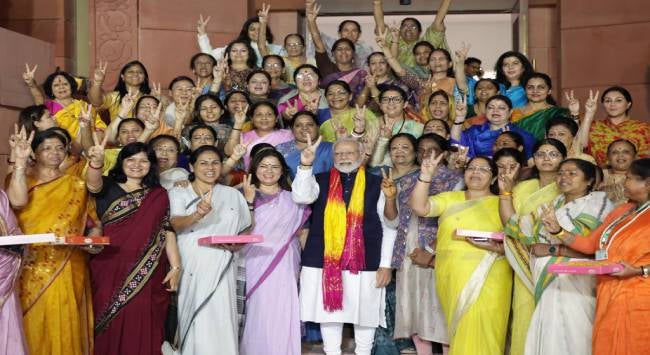Summary
A legislation to mandate one-third reservation for women in India’s lower house of parliament and state assemblies was passed in the special session of the Indian parliament held between 18 and 22 September 2023. This is a welcome step, though the timeline for its implementation and the timing of the announcement have raised concerns.
The recently held five-day special session of the Indian parliament marked the shift of proceedings to the new parliament building which was inaugurated on 28 May 2023. However, the highlight of the session was the passage of the long-delayed legislation mandating one-third reservation for women in the lower house of parliament (Lok Sabha) and state assemblies.
The near-unanimous passage of the women’s reservation bill – or the Constitution (One Hundred and Twenty-eighth Amendment) Bill, 2023, to use the official title – in the special session was historic since several earlier attempts, dating back to the 1990s, had been unsuccessful. The attempts at putting in place reservation for women has primarily foundered on the demands by parties with an Other Backward Classes (OBC) base for a sub-quota for OBCs. In fact, in March 2010, the upper house of parliament (Rajya Sabha) had passed a constitutional amendment to ensure women’s reservation, but the legislation was eventually not taken up by the Lok Sabha.
Under the provisions of the current legislation two new articles – 330A and 332A – were introduced in the Constitution to ensure the 33 per cent reservation for women. It also has a sunset clause of 15 years from the date of enactment of the legislation. The legislation was passed by 454-2 votes in the Lok Sabha and in the Rajya Sabha, where all the 214 members voted in favour of it.
The implementation timetable though is a lengthy and uncertain one since the bill states that the reservation “shall come into effect after an exercise of delimitation is undertaken for this purpose after the relevant figures for the first census taken after the commencement.” Thus, the 33 per cent quota for women is contingent upon the publication of the decennial census results and subsequent delimitation. While the census results have been inexplicably delayed, delimitation can happen only after 2026. Some analysts have voiced concern about the timetable and noted that the quota might take several years to put in place. They have also raised the issue of rotation of constituencies which shall take place after each delimitation, something that happens infrequently. This could mean that there will effectively not be any rotation of seats for long periods.
During the debate on the legislation, several opposition parties pointed out these anomalies as well as the necessity for reservation for the OBCs within the women’s quota. However, the government ignored those demands and asserted that delimitation is necessary to identify women’s reserved seats. The home minister also stated that the reservation will be implemented only after 2029.
While the women’s reservation legislation is a welcome step, two broader issues need to be noted. First, the last-minute announcement of the legislation and rushed passage is symptomatic of the executive hold over the parliament and the marginalisation of the institution. Indeed, the control of the government in drawing up the parliament’s agenda is one of the persistent weaknesses of the institution. The existing rules and procedures have meant that the opposition parties have virtually no role in setting the agenda of the parliament, which is decided by the government, as well as voicing its demands. Second, the Bharatiya Janata Party (BJP), which had committed to pass the women’s reservation bill in its 2014 and 2019 election manifestoes, has waited till the end of Prime Minister Narendra Modi’s second term to do so. Since the women’s quota will not be implemented before 2029 or even later, this was most likely done with an eye on its impact on women voters in the coming assembly polls and next general election.
The quotas for women though are a step in the right direction. The low representation of women in the Indian parliament has been one of its glaring deficits. Though women’s representation in the Indian parliament has risen from 4.4 per cent in the first Lok Sabha to around 15 per cent in the current one, the share of women in the Indian parliament is still much lower than the current global average of 27 per cent and the Asian average of 21 per cent. In fact, India currently ranks 141st among 185 countries in the Inter-Parliamentary Union’s global rankings for women representation in parliaments with India’s neighbours, such as Nepal, Bangladesh and Pakistan, ranking higher.
The low numbers have much to do with the national parties – the BJP and Congress – fielding few women candidates in elections. In the 2019 general election, the proportion of women candidates fielded by the two parties was 13 and 12 per cent respectively. The reluctance of political parties, with the exception of Trinamool Congress and Biju Janata Dal, to nominate women candidates is at a time when the gender gap in voting has narrowed considerably. Notably, the countries with the highest political representation of women, such as Sweden, Norway and South Africa, are ones where political parties have instituted internal quotas for women. Since this has not happened in India, the only way forward was to mandate reservation for women in the legislature.
. . . . .
Dr Ronojoy Sen is a Senior Research Fellow and Research Lead (Politics, Society and Governance) at the Institute of South Asian Studies (ISAS), an autonomous research institute at the National University of Singapore (NUS). He can be contacted at isasrs@nus.edu.sg. The author bears full responsibility for the facts cited and opinions expressed in this paper.
Pic Credit: M Lekhi’s Twitter Account.
-
 More From :
More From :
-
 Tags :
Tags :
-
 Download PDF
Download PDF



